
5 Ways Writers Can Prep for 2025 Goal Setting
Before we roll on to the new writing year, let’s harness our optimism for the blank slate before us and prepare for our 2025 Goal Setting just for writers.

Interestingly enough, the first step in writing is not writing. The first step begins in your head. There is always a spark that lights the fire in a writer to approach any piece of work. It might be something a writer hears or reads that sparks a line of inquiry and brainstorming. It can be a person who seems like a great potential character. This is what we call prewriting.
From this initial spark to the moment when you actually begin writing can vary from writer to writer. Some do a great deal of prewriting and others jump right in and begin to write when an idea comes along that they find compelling, then work in starts and stops, taking breaks to fill in the normal pre-writing activities on an add-needed basis to continue.
Different writers use different methods of getting into the right headspace for writing. This is especially true for fiction writers. Some create playlists of music they associate with the book they’re planning. Some create mood boards of pictures to inspire them about the story’s setting, characters, pets, buildings, props, etc. Mood boards can do double-duty of not only providing inspiration but also giving tangible items for describing important things in the story in a consistent way. For example, if your mood board includes an ivy-covered cottage for one character’s home, you won’t make mistakes about where the door is or what color the house is.

Much of the material you come up with this way won’t go into the piece directly but will help you find your way to believing the story you’re telling. If you don’t believe it, your reader won’t either, so getting to the point where you can suspend your own disbelief will help you get into the writing flow when that point comes.
At the beginning of any fictional piece, we must find the premise: the situation and circumstances that will drive the specific people we’ve created to act. Premise often asks a question. The answers to the questions become the story, and the answers must work with the people and places you create. The answers allow us to begin the process of writing. When we jump into writing before we begin this question-and-answer process, we’ll often successfully get our characters to do stuff, but it may not ultimately be purposeful stuff. And if that happens, the story can feel episodic and without depth.
E.M. Forster wrote in Aspects of the Novel: “The king died and the queen died’ is a story, whereas ‘the king died and the queen died of grief [is] a plot.’ The difference is … that in a story we say ‘and then?’ and in a plot we ask ‘why?'” For me, much of the pre-writing of fiction involves telling myself the story, so that I can find the road that the characters will take and understand why they took it. The why will usually point me toward the deep truth the story will ultimately be about, the theme.
Sometimes the theme stays more elusive, and I don’t realize what it is until I’m in the weeds of the writing process. When that happens, I usually have to go back and do revisions to make the theme clearer for the reader. That doesn’t mean I need to shout it in the face of the reader. Readers are smarter than we give them credit for. However, I do need to be sure the theme isn’t lost, inconsistent, or muddy in the telling of the story.
For nonfiction writers, getting into the writing process will also include questions. The initial spark that draws the nonfiction writer to a subject will also leave him with questions. When I read about a tiny crustacean who could break glass with the power of his claws, I had a lot of questions. How could he have the mass to do something like that? Answer: he doesn’t. He breaks the glass with a concussion caused by speed. That led to more questions: If he’s creating a concussive wave in the water, how does it not injure the animal? And what benefit does the little guy get from this skill? The more questions I asked, the more questions came as I found answers. And this led me on a journey that pulled me into the topic deeper and deeper.
Once I became a temporary expert on this tiny creature, I was ready to sort these answers into a logical order for retelling them to readers. In other words, I was ready to plan how the piece would be organized. At this point, I also had to find the big idea of the piece. The information was all interesting, but what held it all together? What was a takeaway that kids would appreciate? I decided on the theme of how tiny things can be more powerful than you imagine. A takeaway like that has often been used for ants and bees, but this time I was bringing it to the Mantis Shrimp. The resulting article worked well for the testing company who commissioned it, but what I had learned about the Mantis Shrimp also served as a good example of research when I visit elementary school classrooms, because the Mantis Shrimp is fascinating and kids love him.

photo by jan zakelj
Most people completely understand that nonfiction requires research, and research is absolutely essential to the pre-writing process of nonfiction writers, but research is also important to fiction writers. For my Monster Hunters series, research was key to the prewriting of every book. I had to find the cryptids associated with specific states, and then dig deeper to learn more about other aspects of the states. I needed to know the landscape of the state, and I also gathered interesting facts so I could have my fact-obsessed secondary character spout them whenever he got a chance.
I often research vehicles my characters drive and look at what the usual extremes of temperature are in the setting I’ve chosen at the time of year I’m in. Some of the research I do can seem unnecessary as I could quickly gloss over things or guess at what was likely, but I find that research helps me get a feel for the story I’m entering every bit as much as any mood board or character study.
And research can give me unexpected bits that I wouldn’t have considered otherwise. One mystery novel I wrote had to be set in a particular area chosen by the editor. When I began to research the area, I discovered the story of a riverboat that had turned up in a farmer’s field when he excavated for one reason or another. The boat dated to the Civil War and amazing artifacts had been preserved in the wreck. And it was all in a farmer’s field! This was because the shape of rivers changes over time, and the boat had wrecked and sunk in a river that no longer passed there. The research was amazing, but it also inspired a whole new element to the mystery I ended up writing.
Research can be like opening a never-ending series of doors, so for those of us who love research, we do have to take care not to let research stretch the pre-writing too much. But overlooking it can leave you with treasures undiscovered that would have elevated your book beyond the ordinary.
Your prewriting routine may not match mine, or anyone else’s. Each of us develops a system that serves us best. And sometimes, even the most experienced writers will jump in and start writing with minimal pre-writing because they have the experience to recognize that more work will lie ahead when they must do the pre-writing activities concurrent with either writing or revising. And that’s fine if it’s the system that serves them best.
That’s the wonderful thing about writing: it’s a unique journey for each of us, and we’re always working out the path that is smoothest and most direct. I, for one, wouldn’t have it any other way.
With over 100 books in publication, Jan Fields writes both chapter books for children and mystery novels for adults. She’s also known for a variety of experiences teaching writing, from one session SCBWI events to lengthier Highlights Foundation workshops to these blog posts for the Institute of Children’s Literature. As a former ICL instructor, Jan enjoys equipping writers for success in whatever way she can.

Before we roll on to the new writing year, let’s harness our optimism for the blank slate before us and prepare for our 2025 Goal Setting just for writers.

Writers can be thin-skinned when it comes to getting feedback on their work. Let’s look at 4 ways to positively deal with constructive criticism!

Rejection is part of the territory when it comes to being a writer. Today we offer reflection for writers to help redirect your efforts after a rejection.
1000 N. West Street #1200, Wilmington, DE 19801
© 2024 Direct Learning Systems, Inc. All rights reserved.
1000 N. West Street #1200, Wilmington, DE 19801
© 2024 Direct Learning Systems, Inc. All rights reserved.
1000 N. West Street #1200, Wilmington, DE 19801
© 2024 Direct Learning Systems, Inc. All rights reserved.
1000 N. West Street #1200, Wilmington, DE 19801
© 2025 Direct Learning Systems, Inc. All rights reserved.
1000 N. West Street #1200, Wilmington, DE 19801
©2025 Direct Learning Systems, Inc. All rights reserved. Privacy Policy.
4 Comments